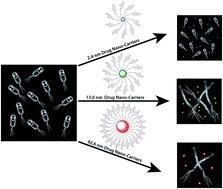当前位置:
X-MOL 学术
›
Nanoscale Adv.
›
论文详情
Our official English website, www.x-mol.net, welcomes your
feedback! (Note: you will need to create a separate account there.)
Size-dependent inhibitory effects of antibiotic nanocarriers on filamentation of E. coli
Nanoscale Advances ( IF 4.6 ) Pub Date : 2020-03-30 , DOI: 10.1039/c9na00697d Preeyaporn Songkiatisak 1 , Feng Ding 1 , Pavan Kumar Cherukuri 1 , Xiao-Hong Nancy Xu 1
Nanoscale Advances ( IF 4.6 ) Pub Date : 2020-03-30 , DOI: 10.1039/c9na00697d Preeyaporn Songkiatisak 1 , Feng Ding 1 , Pavan Kumar Cherukuri 1 , Xiao-Hong Nancy Xu 1
Affiliation

|
Multidrug membrane transporters exist in both prokaryotic and eukaryotic cells and cause multidrug resistance (MDR), which results in an urgent need for new and more effective therapeutic agents. In this study, we used three different sized antibiotic nanocarriers to study their mode of action and their size-dependent inhibitory effects against Escherichia coli (E. coli). Antibiotic nanocarriers (AgMUNH–Oflx NPs) with 8.6 × 102, 9.4 × 103 and 6.5 × 105 Oflx molecules per nanoparticle (NP) were prepared by functionalizing Ag NPs (2.4 ± 0.7, 13.0 ± 3.1 and 92.6 ± 4.4 nm) with a monolayer of 11-amino-1-undecanethiol (MUNH2) and covalently linking ofloxacin (Oflx) with the amine group of AgMUNH2 NPs, respectively. We designed a modified cell culture medium for nanocarriers to be stable (non-aggregated) over 18 h of cell culture, which enabled us to quantitatively study their size and dose dependent inhibitory effects against E. coli. We found that the inhibitory effects of Oflx against E. coli highly depended upon the dose of Oflx and the size of the nanocarriers, showing that an equal amount of Oflx that was delivered by the largest nanocarriers (92.6 ± 4.4 nm) were most potent with the lowest minimum inhibitory concentration (MIC50) and created the longest and highest percentage of filamentous cells, while the smallest nanocarriers (2.4 ± 0.7) were least potent with the highest MIC50 and produced the shortest and lowest percentage of filamentous cells. Interestingly, the same amount of Oflx on 2.4 ± 0.7 nm nanocarriers showed a 2× higher MIC and created 2× shorter filamentous cells than free Oflx, while the Oflx on 13.0 ± 3.1 and 92.6 ± 4.4 nm nanocarriers exhibited 2× and 6× lower MICs, and produced 2× and 3× longer filamentous cells than free Oflx, respectively. Notably, the three different sized AgMUNH2 NPs (absence of Oflx) showed negligible inhibitory effects and did not create filamentous cells. The results show that the filamentation of E. coli highly depends upon the sizes of nanocarriers, which leads to the size-dependent inhibitory effects of nanocarriers against E. coli.
中文翻译:

抗生素纳米载体对大肠杆菌丝状化的尺寸依赖性抑制作用
多药膜转运蛋白存在于原核和真核细胞中并引起多药耐药性(MDR),这导致迫切需要新的和更有效的治疗剂。在这项研究中,我们使用了三种不同大小的抗生素纳米载体来研究它们的作用方式以及它们对大肠杆菌(大肠杆菌)的大小依赖性抑制作用。通过功能化 Ag NPs(2.4 ± 0.7、13.0 ± 3.1 和 92.6 ± 4.4 nm)制备每个纳米颗粒(NP )具有 8.6 × 10 2、9.4 × 10 3和 6.5 × 10 5 个Oflx 分子的抗生素纳米载体(AgMUNH–Oflx NPs )具有单层 11-氨基-1-十一硫醇 (MUNH 2) 并分别将氧氟沙星 (Oflx) 与 AgMUNH 2 NPs的胺基共价连接。我们为纳米载体设计了一种改良的细胞培养基,使其在 18 小时的细胞培养中保持稳定(非聚集),这使我们能够定量研究它们对大肠杆菌的大小和剂量依赖性抑制作用。我们发现 Oflx 对大肠杆菌的抑制作用在很大程度上取决于 Oflx 的剂量和纳米载体的大小,这表明由最大的纳米载体 (92.6 ± 4.4 nm) 递送的等量的 Oflx 是最有效的最低最低抑菌浓度(MIC 50) 并产生最长和最高百分比的丝状细胞,而最小的纳米载体 (2.4 ± 0.7) 最不有效,具有最高的 MIC 50,并产生最短和最低百分比的丝状细胞。有趣的是,在 2.4 ± 0.7 nm 纳米载体上相同数量的 Oflx 显示出比游离 Oflx 高 2 倍的 MIC 和短 2 倍的丝状细胞,而在 13.0 ± 3.1 和 92.6 ± 4.4 nm 纳米载体上的 Oflx 表现出 2 倍和 6 倍的低MIC,分别产生比游离 Oflx 长 2 倍和 3 倍的丝状细胞。值得注意的是,三种不同大小的 AgMUNH 2 NP(不存在 Oflx)显示出可忽略不计的抑制作用,并且不会产生丝状细胞。结果表明,大肠杆菌的丝状化高度依赖于纳米载体的尺寸,这导致纳米载体对大肠杆菌的抑制作用具有尺寸依赖性。
更新日期:2020-03-30
中文翻译:

抗生素纳米载体对大肠杆菌丝状化的尺寸依赖性抑制作用
多药膜转运蛋白存在于原核和真核细胞中并引起多药耐药性(MDR),这导致迫切需要新的和更有效的治疗剂。在这项研究中,我们使用了三种不同大小的抗生素纳米载体来研究它们的作用方式以及它们对大肠杆菌(大肠杆菌)的大小依赖性抑制作用。通过功能化 Ag NPs(2.4 ± 0.7、13.0 ± 3.1 和 92.6 ± 4.4 nm)制备每个纳米颗粒(NP )具有 8.6 × 10 2、9.4 × 10 3和 6.5 × 10 5 个Oflx 分子的抗生素纳米载体(AgMUNH–Oflx NPs )具有单层 11-氨基-1-十一硫醇 (MUNH 2) 并分别将氧氟沙星 (Oflx) 与 AgMUNH 2 NPs的胺基共价连接。我们为纳米载体设计了一种改良的细胞培养基,使其在 18 小时的细胞培养中保持稳定(非聚集),这使我们能够定量研究它们对大肠杆菌的大小和剂量依赖性抑制作用。我们发现 Oflx 对大肠杆菌的抑制作用在很大程度上取决于 Oflx 的剂量和纳米载体的大小,这表明由最大的纳米载体 (92.6 ± 4.4 nm) 递送的等量的 Oflx 是最有效的最低最低抑菌浓度(MIC 50) 并产生最长和最高百分比的丝状细胞,而最小的纳米载体 (2.4 ± 0.7) 最不有效,具有最高的 MIC 50,并产生最短和最低百分比的丝状细胞。有趣的是,在 2.4 ± 0.7 nm 纳米载体上相同数量的 Oflx 显示出比游离 Oflx 高 2 倍的 MIC 和短 2 倍的丝状细胞,而在 13.0 ± 3.1 和 92.6 ± 4.4 nm 纳米载体上的 Oflx 表现出 2 倍和 6 倍的低MIC,分别产生比游离 Oflx 长 2 倍和 3 倍的丝状细胞。值得注意的是,三种不同大小的 AgMUNH 2 NP(不存在 Oflx)显示出可忽略不计的抑制作用,并且不会产生丝状细胞。结果表明,大肠杆菌的丝状化高度依赖于纳米载体的尺寸,这导致纳米载体对大肠杆菌的抑制作用具有尺寸依赖性。











































 京公网安备 11010802027423号
京公网安备 11010802027423号